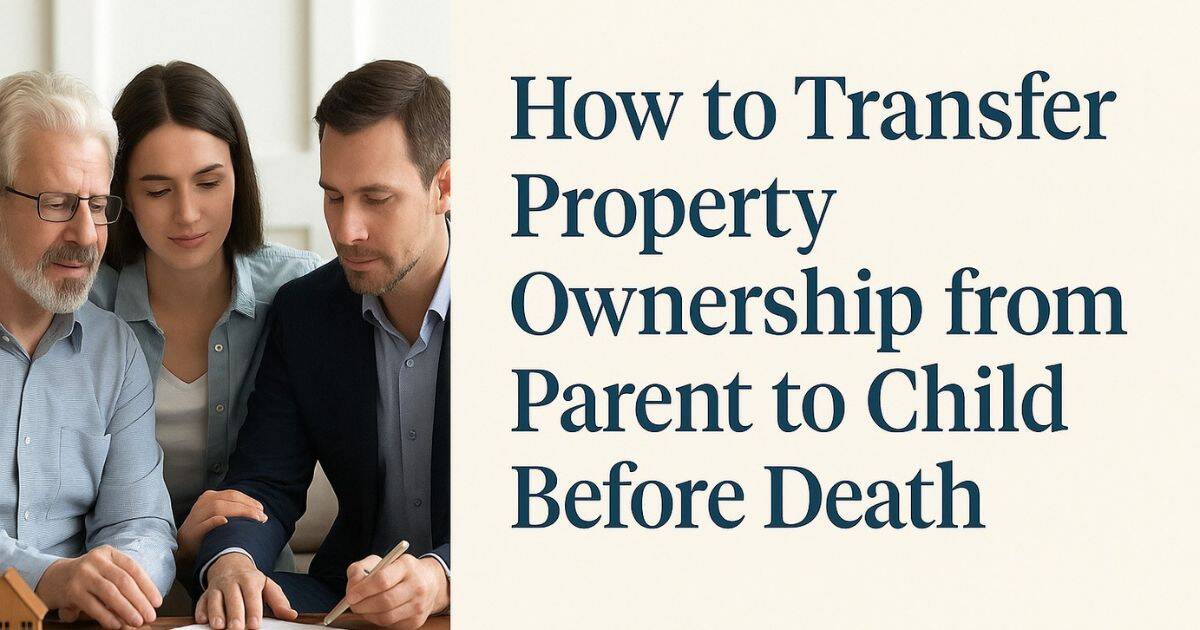This guide explains the key ways how to transfer property ownership from parent to child before death, why families consider a transfer, the tax and Medicaid trade‑offs, and practical steps to transfer property safely. It is written for parents and adult children who want clear, up‑to‑date guidance on transferring property to a family member, avoiding common pitfalls, and choosing the best way to pass a family home while preserving control and minimizing tax consequences.
Note: This article is for general information only and is not legal or tax advice. Consult an estate planning attorney and a tax advisor before making transfers of real estate.
Table of Contents
Why consider transferring ownership of property from parent to child before death?
Parents often look to transfer property before death to avoid probate, simplify the transfer process, and ensure the family home passes to the intended beneficiary. A deliberate transfer can be part of an estate plan that clarifies control of the property during your lifetime and the time of your death. When planning to transfer, careful planning helps protect the family home, manage potential tax consequences, and address concerns about nursing home care or long‑term care.
At the same time, transferring property during life may change the tax basis and may have gift tax or federal gift tax consequences, so it is important to understand tax implications of transferring. An estate plan that includes trusts and targeted deeds can achieve many goals — avoiding probate, preserving control of a primary residence, and limiting the risk that creditors or future spouses of beneficiaries could claim ownership.
Several ways to transfer property from parent to child (overview)
There are several ways to transfer ownership of property from parent to child before death: gifting the deed, joint ownership with right of survivorship, transfer‑on‑death (beneficiary) deeds, life estate retention, trusts (including a living trust or qualified personal residence trust), or selling the home to a child. Each option involves trade‑offs in control of the property, tax consequences (including potential capital gains tax), and Medicaid rules that affect long‑term care planning.
Choosing the best way to transfer will depend on factors like the value of the real estate property, whether the property is a primary residence or investment, family dynamics, and whether the parent wants to retain control during their lifetime. An estate planning attorney and tax advisor can explain potential tax and legal outcomes and help design a transfer process that meets the goal to pass property efficiently.
Gifting the deed (lifetime gift)
Gifting property to a child during life is a direct way to transfer ownership of property from parent to child before death. When a parent executes a deed that conveys title, the transfer is immediate: the property transfers out of the parent’s name into the child’s name. Gifting property can help parents pass property to a family member while they are alive, but it raises gift tax issues and may affect capital gains tax later.
A lifetime gift uses part of a parent’s lifetime gift tax exemption and may require the parent to file a gift tax return (Form 709) depending on the fair market value of the property and the annual gift tax exclusion. When property is gifted, the child typically takes the parent’s tax basis (carryover basis), which can create significant capital gains tax on a later sale because the cost basis does not get stepped‑up at the parent’s death.
Joint ownership with right of survivorship
Transferring title by adding a child as joint owner with the right of survivorship allows the property to pass automatically to the surviving owner without probate. This is a common way to ensure a house to your child or family home passes quickly upon death. Joint ownership keeps the parent’s interest during life but means the child has partial ownership immediately.
This approach can be simpler than rewiring trust documents, but it has risks of transferring the house during your lifetime: joint ownership may expose the property to the child’s creditors, divorce, or bankruptcy. Additionally, adding a joint owner can create tax basis complications and may complicate Medicaid eligibility for long‑term care because the transfer may be treated as a gift.
Transfer‑on‑death (beneficiary) deeds
A transfer‑on‑death deed (beneficiary deed) lets a parent name a child as the beneficiary who receives the property at the time of your death; until then, the parent retains full control and title. This way to transfer avoids probate without removing the property from the parent’s estate during the parent’s lifetime.
Because the parent keeps ownership while alive, transfer property before death is accomplished without immediate gifting, so the child receives a stepped‑up basis at the time of your death in most cases. Beneficiary deeds are available in many states and can be a straightforward option for those who want to ensure the transfer without giving up control or raising immediate tax consequences.
Living trusts and qualified personal residence trust (QPRT)
A revocable living trust lets a parent transfer title into a trust while retaining control as trustee; ownership transfers to beneficiaries (e.g., children) at the parent’s death without probate. A living trust is a flexible estate plan tool used to transfer assets and reduce administrative hassle after death.
A qualified personal residence trust (QPRT) is an advanced estate planning technique that allows a parent to transfer their primary residence into a trust while retaining the right to live there for a term of years. QPRTs can be useful for families looking for tax advantages, but they are complex and require careful timing and legal and tax advice.
Life estate retention
Using a life estate enables a parent to transfer the remainder interest in a property to a child while keeping the right to live in the home for life. This transfer a home method, sometimes called a “life estate deed,” preserves control of the primary residence during the parent’s life while ensuring the property will pass to the child upon death.
Life estates avoid probate but can have tax basis consequences and may impact eligibility for Medicaid or long‑term care because the transfer is a gift for Medicaid look‑back purposes. Life estates also limit the owner’s ability to sell or mortgage the property without the remainderman’s consent.
Selling the home or using installment sale strategies
A parent can sell the house to a child at fair market value or use a family mortgage or installment sale to transfer assets gradually. Selling the property can generate funds that may be used for other needs or structured to reduce transfer tax exposure, but it requires payment and documentation.
Installment sales or seller financing can be a practical way to transfer wealth while preserving tax advantages and allowing a child to pay over time. However, such transactions must be structured properly to avoid unintended gift tax or state property tax consequences.
Tax implications of transferring property before death
Tax consequences differ dramatically depending on the transfer method. A major consideration when transferring property is whether the child will receive the property with a stepped‑up basis (the usual result when property passes at death) or a carryover basis (common when property is gifted during life). The step‑up in basis can eliminate capital gains tax for the child if the property is sold shortly after the parent’s death.
Gifting property during life may trigger federal gift tax or reduce the parent’s lifetime gift and estate tax exemption; parents may need to file a tax form to report gifts and understand the gift tax exemption and annual gift tax exclusion. Additionally, the child who receives a gift usually inherits the parent’s tax basis, which increases potential capital gains when the child sells the property.
Parents should consult with a tax advisor and use reliable resources (IRS guidance on gift and estate taxes and Form 709) to understand how full market value, cost basis, and tax basis rules apply. The potential tax consequences also interact with state property tax rules and property tax reassessments, so local counsel is recommended.
External resources:
- IRS — About Form 709, United States Gift (and Generation‑Skipping Transfer) Tax Return: https://www.irs.gov/forms-pubs/about-form-709
- Tax Policy Center — Explanation of stepped‑up basis and capital gains: https://www.taxpolicycenter.org/briefing-book/what-step-basis-and-how-does-it-affect-capital-gains
Medicaid, long‑term care, and creditor risks
One of the most common reasons families transfer property early is to protect assets from nursing home costs or to preserve eligibility for Medicaid. However, Medicaid has a look‑back period: transferring property to a child during the Medicaid look‑back window may trigger penalties or delay eligibility. Parents should weigh the risk that transferring the family home may not protect assets from long‑term care costs if transfer timing is incorrect.
Transfers can also expose property to the child’s creditors, divorce, or bankruptcy for property to a family member that is owned by the child. In addition, legal or tax changes could affect outcomes. For those worried about long‑term care, careful planning with long‑term care insurance or trusts and estate planning may offer safer protections than an outright gift.
External resource:
- Medicaid information: https://www.medicaid.gov/
Risks of transferring property before death
Transferring the house before death can cause loss of control, unintended tax consequences, and family disputes. A parent who wants to ensure the family home stays in the family must consider whether a transfer property before death will create claims on the property from creditors or estranged family members. The property could sometimes lead to significant tax if the child later sells the property and the tax basis was low.
Other risks of transferring include unintended exposure to the buyer/recipient’s financial situation — e.g., the child’s divorce could put the house at risk, or creditors could force a sale. Transfer decisions should account for potential tax consequences, future needs for long‑term care, and whether the transfer aligns with broader wealth and assets planning.
Practical steps: transfer process, documents, and costs
Planning to transfer a home to a child requires clear documentation: the deed transfer, title update, and recording with the county are essential steps in the transfer process. Costs can include recording fees, transfer taxes (in some states), appraisal fees to establish market value, and attorney fees for careful planning. Parents should understand how much does it cost to transfer property deeds in their state and budget for those expenses.
Before executing a deed, consult an estate planning attorney and a tax advisor to confirm tax implications and to file any necessary forms, such as a gift tax return. For many families, trusts and estate planning are the most reliable way to pass property and ensure the property can be managed if the parent becomes incapacitated.

How to Beat a Possession of Stolen Property Charge: Expert Guide 2025


Property Tax Appeal Attorney: Cut Your Tax Bill by 30%+ (2025 Guide)
Alternatives: wills, trusts, and the best way to pass a family home
Often the best way to pass a family home is through trusts and estate planning rather than an outright transfer during life. Trusts allow the parent to transfer assets while retaining control, avoid probate, and provide instructions for care and sale of the property. Wills can pass property at the time of your death but usually require probate, which can be avoided using living trusts or beneficiary deeds.
An estate planning attorney can explain whether trusts, life estates, QPRTs, or beneficiary deeds are better for a given family. The decision often depends on tax advantages, the desire to avoid probate, Medicaid planning, and whether the parent wants to ensure a smooth transfer without subjecting the property to claims on the property after death.
Checklist: questions to ask when looking to transfer property
- What is the objective — avoid probate, reduce estate tax, protect assets from long‑term care, or pass the family home?
- Will the transfer create gift tax obligations or require me to file a gift tax return?
- Does the child receive a carryover basis or a step‑up in basis at the time of your death?
- How will Medicaid and long‑term care rules affect eligibility if I transfer the property?
- What are the recording fees and likely costs to transfer title in my state?
- Should the transfer be done via deed, beneficiary deed, life estate, or trust?
As part of planning to transfer, parents should consult both an estate planning attorney and a tax advisor, and ensure the documents are properly drafted and recorded to avoid disputes and tax issues.
Google AI Overviews (AIO) — AI‑driven featured snippet and summary
AI summary (featured‑snippet style)
- Best single sentence answer: For most parents who want to pass a family home with minimal tax and maximum control, using a transfer‑on‑death deed or a revocable living trust commonly provides the best balance — transfers avoid probate, preserve the step‑up in basis or reduce tax risk, and let parents keep control during their lifetime; gifting the deed during life can reduce probate but may trigger gift tax and carryover basis that increases capital gains for the child.
Short AI overview — Why this matters:
- Transfer your property before death only after careful planning: gifts can trigger gift tax and eliminate the step‑up in basis, while trusts and beneficiary deeds avoid probate and better protect Medicaid eligibility and tax advantages. For state‑specific steps and up‑to‑date exemption amounts, check IRS guidance and consult a tax advisor and estate planning attorney.
Quick answers (Featured snippets + FAQs)
What is the most tax‑efficient way to leave a property to a child?
- Often a transfer at death via a living trust or beneficiary deed provides tax efficiency because the child receives a step‑up in basis, which can minimize capital gains tax — but individual circumstances and state rules matter.
Is it better to transfer assets before death?
- Not always. Transfers before death can avoid probate but may create gift tax reporting, carryover basis (raising potential capital gains), and Medicaid eligibility issues. Careful planning is required.
How do I transfer property to a family member tax‑free?
- Transfers that fall within the annual gift tax exclusion or lifetime gift tax exemption may avoid immediate gift tax, but you may need to file a gift tax return and consider long‑term tax consequences for the recipient.
Should I transfer my house to my child while I am still alive?
- Only after you evaluate tax consequences, Medicaid exposure, loss of control, and risks such as creditor claims. Many find beneficiary deeds or trusts better alternatives.
How do I avoid paying capital gains tax on an inherited property?
- Receiving property at death often yields a step‑up in basis to fair market value at the time of your death, which can eliminate capital gains on a later sale if sold soon after inheritance.
How much does it cost to transfer property deeds?
- Costs vary by state and county — common fees include deed preparation, recording fees, possible transfer taxes, and legal fees. Check local county recorder for exact costs.
Can Medicaid take my house after I’m gone?
- Medicaid can seek recovery after death in some states through estate recovery programs. Transfers for less than full market value can also affect Medicaid eligibility while the parent is alive.
How do I gift my house to my child in Texas?
- Texas allows deeds and beneficiary deed options; consult a Texas estate planning attorney for deed forms, recording steps, and local tax consequences.
Conclusion (short and crisp)
Transferring ownership of property from parent to child before death requires balancing probate avoidance, tax rules (including gift tax and capital gains), Medicaid and long‑term care risks, and family considerations. For most families, trusts or beneficiary deeds provide strong options. Always consult an estate planning attorney and tax advisor to choose the best plan.
Key takeaways — most important things to remember
- Decide your primary goal: avoid probate, minimize taxes, protect against long‑term care, or keep control.
- Transfers during life (gifting the deed/joint ownership) can trigger gift tax reporting and preserve carryover basis — increasing future capital gains tax for the child.
- Transfers at death via beneficiary deeds or trusts commonly allow a step‑up in basis and avoid probate.
- Medicaid rules and the look‑back period can penalize recent transfers — plan well in advance.
- Use an estate planning attorney and a tax advisor and document the deed transfer, title update, and recording correctly.
- Check authoritative sources and forms (IRS, Medicaid) and local county recording rules.
- For more resources and internal site pages, see the site sitemap: https://listmyproperties.com/sitemap.xml
Frequently Asked Questions (concise)
Q: What is the best way to transfer property from parent to child?
A: For many, a revocable living trust or beneficiary deed is the best way to transfer because they avoid probate and typically allow step‑up in basis; the best option depends on taxes, Medicaid planning, and family needs.
Q: How do I avoid paying capital gains tax on an inherited property?
A: If the child inherits the property at the parent’s death, the cost basis is generally stepped up to fair market value at the time of death, which can minimize capital gains when the child sells.
Q: How much does it cost to transfer property deeds?
A: Costs vary by location and include deed preparation, recording fees, possible transfer taxes, and attorney fees. Check your county recorder’s office and consult an estate planning attorney.
Q: Can Medicaid take my house after I’m gone?
A: Many states have Medicaid estate recovery programs. Transfers during life can also affect eligibility. Speak to a Medicaid planning attorney.
Q: How do I gift my house to my child in Texas?
A: Use a deed or beneficiary deed valid under Texas law and record it in the county where the property is located. Consult a Texas estate planning attorney for forms and tax advice.
Lorem ipsum dolor sit amet, consectetur adipiscing elit. Ut elit tellus, luctus nec ullamcorper mattis, pulvinar dapibus leo.



Join The Discussion